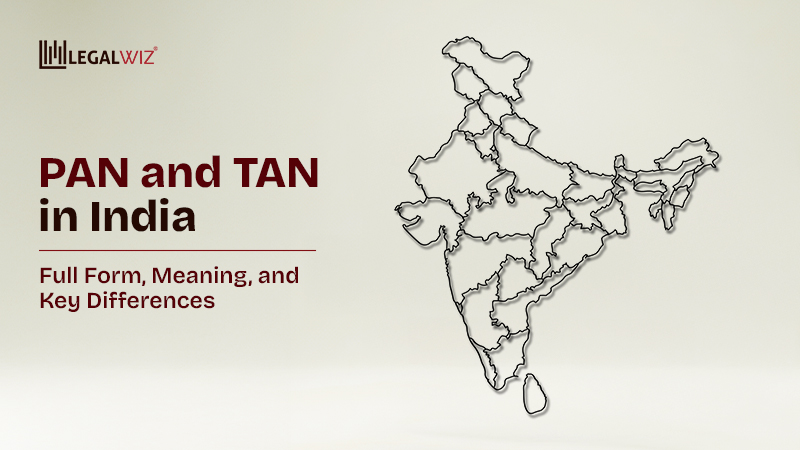PAN and TAN in India: Full Form, Meaning, and Key Differences
When dealing with the Income Tax Department, whether for filing returns, deducting tax, or opening a business account, you’ll often come across the terms PAN and TAN. Though both are government-issued identification numbers, they serve entirely different purposes in India’s tax system.
These two identifiers are essential for every entrepreneur looking to register a business in India or carry out any financial transactional activity.
To obtain a PAN card and a Tax Deduction or Collection Account Number (TAN) card, one must be familiar with the distinctions between the two before launching a company.
Here in the blog, we’ll learn the difference between PAN and TAN. As well as what PAN or a TAN Number means, and how they differ from each other in India.
Key Differences Between PAN and TAN
| Basis | PAN | TAN |
| Full Form | Permanent Account Number | Tax Deduction and Collection Account Number |
| Purpose | Used for all tax-related identification and financial transactions | Used for TDS/TCS deduction and reporting |
| Issued To | Individuals, companies, and other taxpayers | Entities deducting or collecting tax at source |
| Format | 10-character alphanumeric (ABCDE1234F) | 10-character alphanumeric (MUMA12345B) |
| Mandatory For | Taxpayers/Non-Taxpayers, Foreign nationals and entities | Individuals who deduct or collect 203A taxes |
| Laws | Section 139A, Income Tax Act, 1961 | Section 203A, Income Tax Act, 1961 |
| Forms to fill | Indian Citizenship – Form 49A Foreign National – Form 49AA | Form 49B |
| Issued By | Income Tax Department | Income Tax Department |
| Penalty for Not Having | ₹10,000 (under Section 272B) | ₹10,000 (under Section 272BB) |
What is PAN? (Permanent Account Number)
The Income Tax Department issues a Permanent Account Number (PAN) to every Indian taxpayer. It is a 10-digit alphanumeric identity. This number keeps track of all of a person or business’s financial and tax transactions in one place.
The PAN links all tax-related operations, such as payments, TDS, TCS, and income tax returns, to a specific individual.
For a better understanding of the PAN registration process, read our guide on how to apply PAN card for a company and ensure your business stays tax-compliant from the start.
Who needs a PAN:
- Individuals: Indian citizens with valid ID and address proof
- Minors: Parents or guardians can apply using their documents and the minor’s DOB proof
- HUFs: Applied through the Karta for financial transactions
- LLPs: Required for tax filing and business operations
- Partnership Firms: Mandatory for filing income tax returns
- Companies: Must quote PAN in all financial transactions
- Trusts/AOPs/BOIs: Apply using Certificate of Registration
- Local Authorities: Apply with a registration or agreement copy
- Artificial Juridical Persons: Apply with registration or government-issued identity proof
- Foreign Citizens: Must apply if involved in financial transactions in India
Uses of PAN:
- Filing income tax returns
- Opening a bank account
- Conducting high-value financial transactions
- Serving as identity proof for tax purposes
- Buying or selling a motor vehicle (other than two-wheelers)
- Applying for a credit or debit card
- Opening a demat account
- Making cash payments of ₹50,000 or more
- Depositing over ₹50,000 in a single day at a bank
Example of PAN:
A PAN is a 10-character alphanumeric code with a fixed structure:
- The first five characters are letters
- The next four characters are numbers
- The last character is a letter
Example: ABCDE1234F
Here’s what each part means:
- First three letters (ABC): Random alphabetic series.
- Fourth letter (D): Represents the type of holder — for example, P for individual, C for company, H for HUF, A for AOP, etc.
- Fifth letter (E): The first letter of the person’s or entity’s name.
- Next four digits (1234): Sequential numbers issued by the system.
- Last letter (F): A check digit used for verification.
What is TAN? (Tax Deduction and Collection Account Number)
When you start a business and hire people, one of the most important things to think about is obtaining a Tax Deduction Account Number (TAN). If a business or employer is responsible for deducting tax from payments, they need a TAN so the government can track those deductions properly.
Businesses deducting tax at source without a valid TAN may face penalties. After receiving a TAN, businesses are required to submit TDS returns every three months.
Who needs a TAN:
You must obtain TAN registration if you:
- Deduct TDS on salaries, rent, contractor payments, or professional fees
- Are an individual required to deduct TDS under the Income Tax Act
- Are a firm or company making payments covered under TDS provisions
- Collect tax at source (TCS) on specified sales or services
Example: If a company pays a consultant professional fees above ₹30,000, it must deduct TDS and quote its TAN in the transaction.
Uses of TAN:
TAN Is Compulsory for Quoting
You must quote your TAN in:
- TDS/TCS returns
- Tax payment challans
- TDS certificates (Form 16, 16A, etc.)
- Any correspondence with the Income Tax Department
For more insight on income tax documentation, see our detailed post on what is Form 16. It breaks down the structure, parts, and why it’s essential for your tax return filings.
Penalty for Non-Compliance
A penalty of ₹10,000 under Section 272BB applies for not obtaining a TAN or quoting an incorrect TAN.
Separate TAN for Each Entity
Each firm, company, or individual deductor must have a unique TAN. One TAN cannot be shared between multiple entities.
TAN vs. PAN
PAN identifies a taxpayer, while TAN identifies a tax deductor or collector. Both are independent and serve different purposes.
Mandatory for Filing TDS Returns
You cannot file TDS returns or upload TDS statements on the TRACES portal without a valid TAN.
Example of TAN:
TAN Number: MUMA12345B
Here’s how it is structured:
- First four letters (MUMA): Represent the city or jurisdiction code associated with the Income Tax department issuing the TAN (for example, ‘DEL’ for Delhi or ‘MUM’ for Mumbai)
- Next five digits (12345): A unique number assigned to each deductor or collector.
- Last letter (B): A check code generated automatically for verification.
Example to Understand the Difference Between PAN and TAN
Suppose ABC Pvt. Ltd. is a registered company.
- It uses PAN to file its own income tax returns and carry out business transactions
- It uses TAN to deduct and deposit TDS on employee salaries or vendor payments
In short, PAN identifies the company as a taxpayer, while TAN identifies it as a tax deductor.
How to Apply for PAN and TAN in India
For PAN:
Required Documents for PAN Card:
- Address Proof: Aadhaar card or any valid address document (for individuals).
- Photograph: Two passport-size photos (for individuals).
- Birth Certificate: Required for minors.
- Parents’ Proof: ID and address proof of either parent (for minors).
- Certificate of Incorporation: Mandatory for companies and LLPs.
- Agreement: Partnership or LLP agreement, as applicable.
Applying for a PAN is a straightforward process. All you need to do is:
- Go to the NSDL or UTIITSL website and choose “Apply for PAN.”
- Fill out Form 49A (for Indian nationals) or Form 49AA (for overseas applicants with taxable income in India)
- Provide proper identity and address evidence
- Pay the application fees
- Your PAN number will be issued after the application and verification
For TAN:
Documents Required for TAN Application:
- Address Proof: Aadhaar card or any valid address document.
- Applicant Information: Name, contact details, and signature of the applicant.
- Certificate of Incorporation: Required for companies and LLPs.
- Agreement: Applicable for LLPs and Partnership Firms.
Employers or businesses handling TCS/TDS can follow the steps below to apply for TAN.
- Go to the NSDL official website
- Fill out Form 49B with information about your firm
- Send in all the required supporting documentation
- Pay the cost for processing
- Once the application is approved and finished, you will get the TAN number
Common Mistakes and Tips While Using PAN and TAN
| Common Mistake | What Happens | Tip to Avoid It |
| Using PAN instead of TAN in TDS filings | The return gets rejected or attracts penalties | Always use TAN for TDS/TCS-related transactions and PAN for income tax purposes |
| Not quoting TAN in challans or TDS certificates | Non-compliance can lead to fines under the Income Tax Act | Double-check that TAN is correctly mentioned in all TDS/TCS documents |
| Using personal PAN for business transactions | Creates discrepancies in tax records and compliance | Use the company or firm’s registered PAN for all business-related dealings |
| Not updating PAN or TAN details after structural or address changes | Leads to mismatched records and possible delays in processing | Update your PAN or TAN details promptly on the Income Tax portal |
Note: Keep both numbers valid, active, and correctly linked to the right entity to ensure smooth tax compliance.
Conclusion
Your PAN is your tax identification, and your TAN is your tax deduction identity. Both are necessary for easy and legal financial transactions in India.
If you fall into one of the categories that need one or both, make sure you apply appropriately and keep accurate records to be compliant.
The appropriate ID makes sure you’re following the rules and keeps your records clean, whether you’re making money or paying taxes.
Do you need assistance getting a PAN or TAN? Let the experts at LegalWiz.in take care of everything for you promptly, reliably, and entirely online.
Frequently Asked Questions
Is it mandatory to have both PAN and TAN?
Not all the time. Everyone who pays taxes must have a PAN. However, only those who are responsible for collecting or deducting tax at source (TDS/TCS) need a TAN.
Can one TAN be used for multiple branches of a company?
No. Even if they are part of the same company, each branch or division that takes TDS must have its own TAN.
What happens if I quote an incorrect TAN or PAN?
If you give the wrong number, your TDS returns might be turned down, and you could have to pay a ₹10,000 fine under the Income Tax Act.
How can I verify my PAN or TAN details online?
You may check both your PAN and TAN on the official website of the Income Tax Department or on the NSDL (now Protean) portal by entering the digits.
Can foreign entities apply for PAN and TAN in India?
Yes. If a foreign firm or person wants to do business in India and pay taxes, they need to get a PAN and TAN.

Sapna Mane
Sapna Mane is a skilled content writer at LegalWiz.in with years of cross-industry experience and a flair for turning legal, tax, and compliance chaos into clear, scroll-stopping content. She makes sense of India’s ever-changing rules—so you don’t have to Google everything twice.







